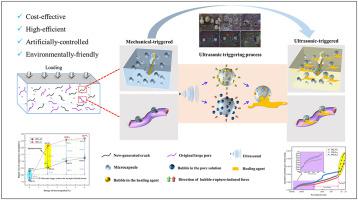Cement and Concrete Composites ( IF 10.8 ) Pub Date : 2021-01-22 , DOI: 10.1016/j.cemconcomp.2021.103951 Na Xu , Zijian Song , Ming-Zhi Guo , Linhua Jiang , Hongqiang Chu , Chun Pei , Peipei Yu , Qingyang Liu , Ziming Li

|
Microcapsule-mediated self-repair of concrete represents an attractive method to improve the durability of concrete. However, it is quite challenging to timely and controllably trigger the microcapsule self-healing materials with the onset of cracks. This study attempts to employ ultrasonic wave as a cost-effective, artificially-controlled, high-efficient and environmentally-friendly trigger to orchestrate microcapsule-induced self-healing activities in concrete. A traditional microcapsule (i.e., the UF/E microcapsule) was synthesized and characterized to study the feasibility and effectiveness of the ultrasonic wave trigger. Cement mortars with and without microcapsules were prepared for ultrasonic/mechanical triggering tests, and the strength repair rates were analyzed. Stereomicroscope and SEM were used to observe the morphologies of the microcapsules in mortars before and after ultrasonic triggering. In addition, MIP was used to analyze the pore structures of mortars subjected to different ultrasonic trigger times. The results showed that the obtained microcapsules (with a particle size range of 100 μm–300 μm) were uniformly distributed in the mortar samples. The enhancement of strength repair rates of mortars triggered by ultrasonic were 2–4 times higher than mechanical-triggered ones. The morphological observations also illustrated that ultrasonic wave delivered a better triggering effect on the microcapsules. It was also found that the optimal ultrasonic time was 10 min under the conditions used in this study (40 kHz and 0.2 w/cm2). Findings from this study demonstrated that ultrasonic wave induced triggering of microcapsules was easily-controllable and cost-effective. Thus, this novel trigger method holds great potential for promoting the application of microcapsules technologies in cementitious materials.
中文翻译:

利用超声波作为微胶囊自修复胶凝材料的新触发点
微胶囊介导的混凝土自我修复代表了一种提高混凝土耐久性的有吸引力的方法。但是,及时且可控地触发具有裂纹发生的微胶囊自愈材料是非常具有挑战性的。这项研究试图利用超声波作为一种经济有效,人为控制,高效且环保的触发器,以协调混凝土中的微胶囊诱导的自愈活动。合成并表征了传统的微胶囊(UF / E微胶囊),以研究超声波触发的可行性和有效性。制备具有和不具有微胶囊的水泥砂浆以进行超声/机械触发测试,并分析强度修复率。超声触发之前和之后,使用立体显微镜和SEM观察砂浆中微囊的形态。此外,MIP用于分析砂浆在不同超声触发时间下的孔结构。结果表明,所获得的微胶囊(粒径范围为100 μm–300μm)均匀分布在砂浆样品中。超声触发的砂浆强度修复率的提高是机械触发的提高2到4倍。形态学观察还表明,超声波对微胶囊具有更好的触发作用。还发现在本研究中使用的最佳超声时间为10分钟(40 kHz和0.2 w / cm MIP用于分析砂浆在不同超声触发时间下的孔结构。结果表明,所获得的微胶囊(粒径范围为100 μm–300μm)均匀分布在砂浆样品中。超声触发的砂浆强度修复率的提高是机械触发的提高2到4倍。形态学观察还表明,超声波对微胶囊具有更好的触发作用。还发现在此研究中使用的最佳超声时间为10分钟(40 kHz和0.2 w / cm MIP用于分析砂浆在不同超声触发时间下的孔结构。结果表明,所获得的微胶囊(粒径范围为100 μm–300μm)均匀分布在砂浆样品中。超声触发的砂浆强度修复率的提高是机械触发的提高2到4倍。形态学观察还表明,超声波对微胶囊具有更好的触发作用。还发现在此研究中使用的最佳超声时间为10分钟(40 kHz和0.2 w / cm 结果表明,所获得的微胶囊(粒径范围为100 μm–300μm)均匀分布在砂浆样品中。超声触发的砂浆强度修复率的提高是机械触发的提高2到4倍。形态学观察还表明,超声波对微胶囊具有更好的触发作用。还发现在此研究中使用的最佳超声时间为10分钟(40 kHz和0.2 w / cm 结果表明,所获得的微胶囊(粒径范围为100 μm–300μm)均匀分布在砂浆样品中。超声触发的砂浆强度修复率的提高是机械触发的提高2到4倍。形态学观察还表明,超声波对微胶囊具有更好的触发作用。还发现在此研究中使用的最佳超声时间为10分钟(40 kHz和0.2 w / cm2)。这项研究的结果表明,超声波诱导的微胶囊触发容易控制且具有成本效益。因此,这种新颖的触发方法具有巨大的潜力,可以促进微囊技术在胶凝材料中的应用。





















































 京公网安备 11010802027423号
京公网安备 11010802027423号